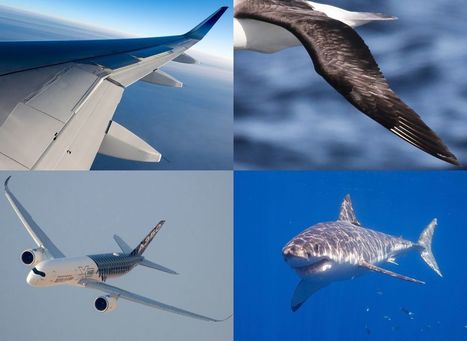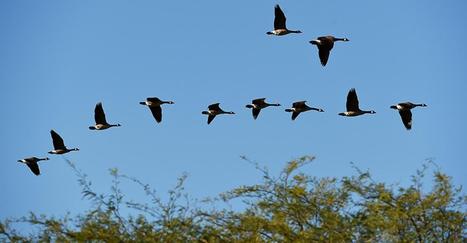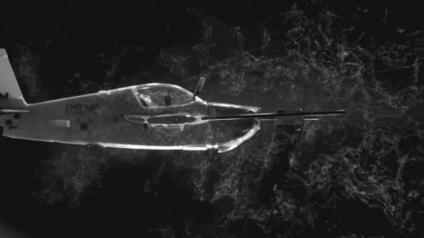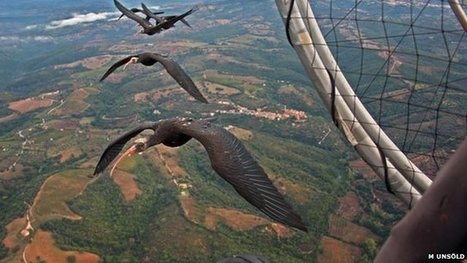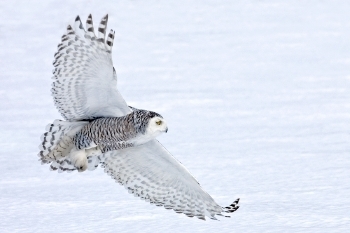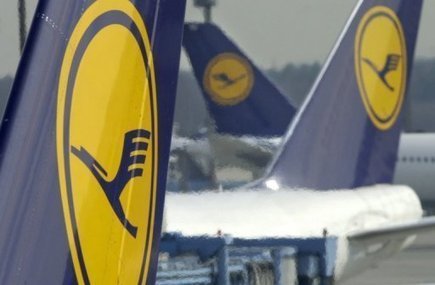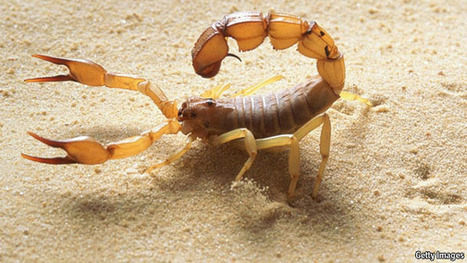 Your new post is loading...
 Your new post is loading...
The growing science of biomimicry focuses on what humanity can learn from the world, and Airbus engineers are learning quite a lot about efficient solutions for aircraft design that nature has spent millions of years refining.
"Boeing Co. and NASA have found an inexpensive way to cut airline fuel bills by borrowing a trick from the world’s greatest long-distance aviators: migratory birds. By lining up cruising aircraft in a V-shaped formation favored by Canada geese, carriers would be able to produce a leap in efficiency without investing in structural makeovers or futuristic technology. The idea is to link the flying convoys safely using navigation and collision-avoidance tools that already are widely installed in cockpits."
"The habits and anatomy of birds are being used by boffins at Airbus to develop quieter and more fuel efficient planes. The aviation giant, which makes and designs wings in Broughton, Flintshire, and Filton, Gloucestershire, employs Professor Norman Wood to unlock the mysteries of the natural world to help gain a commercial advantage.
It is using so-called ‘biomimicry’ in the design of intelligent wings that react automatically to the environment, just as an eagle’s or a peregrine falcon’s do."
"Airbus and its subsidiary APWorks, in collaboration with Autodesk-owned architecture firm The Living, has started 3D printing the world’s largest metal 3D printed airplane part. The jet partition, 3D printed in a high-tech alloy called “Scalmalloy”, is 45% lighter than current partitions. [...] To create the most durable and lightweight design possible, the project team sought inspiration from nature. Bionics, which involves examining natural mechanics to see how they could be mimicked in technological devices, has been crucial in the production of the 3D printed component. The jet partition was created with custom algorithms, which generated a design that mimics cellular structure and bone growth. Airbus has also been exploring weight-saving aircraft structures based on the construction of super-strong water lilies, and torsion springs based on fish jaws."
"Airbus believes that much can be learned by studying the natural world, and in putting this philosophy into practice as a global innovation leader, the company has launched numerous projects inspired by biological systems and methods in order to develop new technical solutions. [...] One bionics project at Airbus seeks a new method for stiffening surfaces by leveraging physical qualities of the Victoria water lily (Victoria amazonica) – which has intrigued engineers with its superior ability to support significant point loads. The plant’s leaf vein structure provides Airbus with a model for reinforcing surfaces, and can now be found on the inner surface of a 3D-printed aircraft spoiler drawn up as part of a concept study."
"Inspired by nature's own anti-turbulence devices – feathers – researchers have developed an innovative system that could spell the end of turbulence on flights. Researchers from the Unmanned Systems Research Team at RMIT University in Melbourne, Australia, have lodged a provisional patent on the system, which mimics the way feathers help birds detect disturbances in the air."
"The mystery of why so many birds fly in a V formation may have been solved. Scientists from the Royal Veterinary College fitted data loggers to a flock of rare birds that were being trained to migrate by following a microlight. This revealed that the birds flew in the optimal position - gaining lift from the bird in front by remaining close to its wingtip. The study, published in the journal Nature, also showed that the birds timed their wing beats."
"What do velvet, the skin of a shark, and advancements in aircraft aerodynamics have in common? The answer rests in a field of scientific study that involves examining what can be extracted, learned and duplicated from the natural world. Known as ‘biomimicry,” or biologically inspired engineering, this is the study and imitation of nature’s best ideas to help solve human challenges. A growing number of aeronautical innovations have been inspired by an array of natural structures, organs and materials – and these tried and tested patterns of the natural world will continue to be a powerful source of inspiration in the future." Photo details: Bald Eagle , Morris Valley Road, Harrison Mills, British ColumbiaCopyright © 2008, Alan D. Wilson. http://www.naturespicsonline.com
Owls have the uncanny ability to fly silently, relying on specialized plumage to reduce noise so they can hunt in acoustic stealth. Researchers from the University of Cambridge, England, are studying the owl's wing structure to better understand how it mitigates noise so they can apply that information to the design of conventional aircraft.
|
"[...] a team of Danish researchers has designed a surprisingly “organic” model for the inside of an airplane wing by harnessing the immense computing power of 8,000 CPUs. In a letter published in Nature, Niels Aage and colleagues from the University of Denmark showed off an intricately curved and fractal-like airfoil design that’s strikingly similar to the interior of a bird’s wing and beak."
"Ribbon halfbeak are a species of fish with the ability to fly above the sea surface - but unlike true 'flying fish', they lack the necessary hind wing fins. So how do they fly? Dr Yoshinobu Inada from Tokai University, Japan says, "Investigating the design of ribbon halfbeak could provide useful information for the optimal design of tandem wing airplanes."
"It only takes a brief journey down a B road during the summer months to end up with a car looking like it has driven through a plague of insects. Amplify this effect by the power of a space shuttle wingspan and bug remnants can result in a significant increase in drag. The problem is that when an insect hits an aircraft at speed its mass ruptures and undergoes some chemical changes which make it stickier. Flying through a swarm of insects leads to an accumulation of debris on the leading edge of wings which creates drag and increases fuel consumption. NASA researchers, in collaboration with engineers at Langley and Boeing, studied the microscopically-rough texture of lotus leaves in order to understand how the surface is so effective at repelling dirt, dust and water."
Many owls have the extraordinary ability to fly in almost complete silence. Could this adaptation have implications for the way we design aircraft? Photo details: Snowy Owl, Saint Barthelemy, Near Montreal, Quebec. Copyright © 2010, Alan D. Wilson. http://www.naturespicsonline.com
"[...] In a macroscopic axis, the A350 XWB considers the actively deformation of the surfaces to provide the best aerodynamic performance and control of load for each flight conditions; takeoff, climb, cruise, approach, landing, maneuver, turbulence-encounters, etc. This is what birds, fish and marine mammals perform beautifully, called "morphing". The idea is to move from a 'rigid' world to flexibility and adaptation technologies."
Researchers are developing a bio-inspired unmanned aircraft capable of soaring like birds, boosting energy efficiency and endurance. The research team is aiming to be the first in the world to demonstrate an autonomous unmanned aircraft that can mimic birds by using updrafts around buildings to stay airborne.
"The secrets of owls' near silent wings has been revealed by scientists who could now use the technology to develop quieter aircraft. A new study has shown how the bird of prey's naturally evolved plumage gives the hunting advantage of 'acoustic stealth', allowing it to sneak up on targets. Research found that many owl species have developed feathers which can effectively eliminate the aerodynamic noise from their wings as they cut through the air."
In its never-ending quest to develop more aerodynamic, more fuel-efficient aircraft, the aviation industry believes the ocean's oldest predator, the shark, could hold the key to cutting energy consumption.
The north African desert scorpion, Androctonus australis, is a hardy creature. Most animals that live in deserts dig burrows to protect themselves from the sand-laden wind. Not Androctonus. It usually toughs things out at the surface. Yet when the sand whips by at speeds that would strip paint away from steel, the scorpion is able to scurry off without apparent damage. Han Zhiwu of Jilin University, in China, and his colleagues wondered why. Their curiosity is not just academic. Aircraft engines and helicopter rotor-blades are constantly abraded by atmospheric dust, and a way of slowing down this abrasion would be welcome. Dr Han suspects that scorpions may provide an answer. As he writes in Langmuir, he has discovered that the surface of Androctonus's exoskeleton is odd. And when that oddness is translated into other materials it seems to protect them, as well.
|
 Your new post is loading...
Your new post is loading...
 Your new post is loading...
Your new post is loading...






